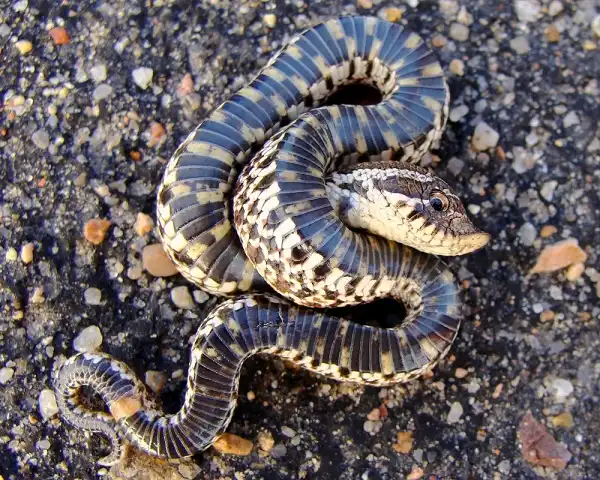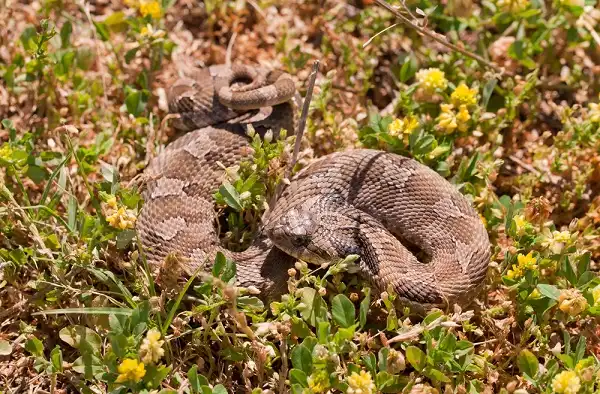If you’re lucky enough to spot a Western hognose snake in the wild, you’ll be rewarded with one of nature’s most fascinating creatures. These snakes are known for their comical behavior, which often includes acting dead when threatened. But don’t let their harmless act fool you – these snakes are incredibly venomous and should be respected. In this blog post, we’ll explore everything there is to know about Western hognose snakes, from their unique physical features to their interesting habits. So sit back and get ready to learn all about one of North America’s most unique snakes!

Western Hognose Snake Description
The Western Hognose Snake is a small to medium-sized species native to the United States and Mexico. They are typically characterized by their unique dorsal pattern of alternating bands or blotches, which helps them to blend in with their environment. The colors of these markings vary from browns to grays and even yellows, depending on the snake’s location. Western Hognose Snakes are also known for their defensive behavior, often rolling over onto their back and playing dead when threatened. This serves as an effective defense mechanism against predators since they don’t actively hunt. In addition, they have long fangs that can inject venom into prey, although they are generally non-aggressive toward humans.
Western Hognose Snake Habitat
The Western Hognose Snake has a wide range of habitats across the United States and Mexico, from grasslands to deserts, forests, and even coastal areas. They prefer open dry environments with plenty of loose soil and vegetation cover that they can use for burrowing or hiding. This species is also known to inhabit rocky crevices in some regions. Western Hognose Snakes typically remain close to where they were born and will rarely venture more than a few hundred yards away from their established home range. As long as there are ample food sources available and suitable temperatures, these snakes are content to stay in one place for extended periods of time. When temperatures drop, Western Hognose Snakes will enter into a period of brumation – similar to hibernation – during which their metabolic rate drastically slows down, allowing them to survive the cold winter months without eating or drinking water. These snakes usually dig deep underground tunnels for protection against predators and extreme temperatures.
Western Hognose Snake Diet
The Western Hognose Snake is an opportunistic feeder that mainly preys on small species of rodents and lizards, such as voles, mice, skinks, and geckos. Their upturned snout is perfectly adapted for digging into the ground where these creatures live, which gives them a great advantage over other species of snake. In addition to their primary prey source, they have also been known to feed on amphibians, invertebrates like caterpillars or crickets, and even carrion in some cases. In terms of nutrition, it is important to note that rodents make up the majority of a Western Hognose Snake’s diet in terms of nutritional value. They provide essential proteins and lipids that help keep the snake healthy and strong. The other prey items they consume may provide additional sources of calcium, phosphorus, or other minerals necessary for proper bodily functions.

Western Hognose Snake Size
The Western Hognose Snake is typically a medium-sized species that can grow from 18 – 30 inches in length. Adults are typically larger than juveniles, with males typically being larger than females. The most common coloration of this species is a light brown or yellowish-brown, although more vibrant colors such as orange or red have been known to occur in some specimens. Due to their adaptation to burrowing into the ground, Western Hognose Snakes have long, tubular bodies with short tails and wide heads. Their scales are smooth and glossy, making them well-suited for digging through the soil without becoming stuck or tangled in roots or debris. They also have eyes on the top of their heads which enable them to scan for prey above ground while staying hidden beneath the surface. Overall, Western Hognose Snakes are relatively small snakes compared to other species; however, they possess powerful defensive capabilities which make them formidable predators when encountered by humans or other animals in the wild. With proper handling techniques, they can make delightful pets that bring joy to many reptile enthusiasts around the world!
Western Hognose Snake Lifespan
The average lifespan of a Western Hognose Snake in the wild is around 5-10 years, although some individuals have been known to live up to 20 years. In captivity, these snakes can potentially live even longer due to the lack of predators and access to food and water. Western Hognose Snakes grow relatively slowly compared to other snake species, with juveniles typically only reaching half of their adult size after two years. They continue to grow slowly until they reach around four years old, at which point their growth rate begins to level off. Females tend to grow slightly larger than males, although both sexes reach similar lengths by adulthood. Overall, Western Hognose Snakes are relatively long-lived creatures that can provide many years of enjoyment for their owners. With proper care and diet, these snakes can thrive in captivity and reach an age where they are considered senior citizens!
Western Hognose Snake Behavior
Western Hognose Snakes are solitary creatures who spend most of their time underground, burrowing through the soil in search of prey or a safe spot to sleep. During the day they can often be seen lying motionless in their burrows with just their head poking out while at night they come out to hunt. When threatened, Western Hognose Snakes will first put on an impressive display of flattening their bodies and displaying their hoods in a threatening manner. This is thought to be a warning sign to potential predators that the snake is venomous and should not be approached. Although these snakes may seem aggressive, they actually prefer to avoid contact with humans and will usually try to flee rather than fight if confronted. However, if cornered or handled roughly they may lash out defensively with their fangs which can deliver a painful and potentially dangerous bite. Therefore it is best to never corner or pick up a Wild Hognose Snake unless absolutely necessary for its safety.

Western Hognose Snake Speed
Western Hognose Snakes are generally considered to be a slow-moving species. They primarily use their speed and agility in ambushing their prey rather than trying to outrun it. When threatened, these snakes rely more on bluffing and intimidating their predators than on attempting to outrun them. The average speed for most Western Hognose Snakes is around 0.2 – 0.3 meters (0.7 – 1 foot) per second when they are moving on the ground. This may not sound like much but it can actually be quite quick when compared to other reptilian species that tend to move at a much slower pace or stay relatively still while hunting.
Because of their burrowing habits, Western Hognose Snakes are also very adept at moving through the soil and underground tunnels with ease. They accomplish this by using specialized scales along the underside of their bodies which help them grip the soil and push themselves through narrow spaces with minimal effort. In addition to being able to quickly maneuver through tight spaces, Western Hognose Snakes can also move surprisingly fast when slithering across rocky surfaces or open expanses of sand or dirt. When sprinting across these terrains, these snakes have been known to reach speeds up to 2 meters (6 feet) per second!
Western Hognose Snake Hunting
Western Hognose Snakes are formidable hunters that utilize a variety of techniques to capture their prey. Their primary feeding strategy is ambush hunting, in which they remain motionless until an unsuspecting meal passes by. They then strike with incredible speed and accuracy, using their short but powerful jaws to grasp and hold onto their prey while they dispense a venomous bite. When successful, the Western Hognose Snake will then swallow its kill whole, utilizing stretchy ligaments inside the mouth to expand and accommodate larger meals. As well as ambush hunting, these snakes also practice active foraging behaviors such as chasing after rodents or other small animals with surprising bursts of speed.
Western Hognose Snakes are also known to burrow underground in search of food, making use of their shovel-like noses to dig through dirt and soil in pursuit of worms or other burrowing creatures. In addition to being able to detect food sources by smell or sight, Western Hognose Snakes can also sense heat emitted from potential prey items using specialized receptors located in the head called pit organs. By sensing even minute differences in temperature between the ground and whatever object is nearby, these reptiles can infer the presence of food without ever seeing it!

Conclusion
Western Hognose Snakes are remarkable reptiles with a surprisingly wide range of capabilities. From their impressive speed and agility to their keen senses and highly intelligent hunting techniques, these small but mighty creatures make fantastic companions for those looking for an exciting pet experience! With proper care and attention, owning a Western Hognose Snake can be both rewarding and enjoyable. So next time you’re considering getting a pet snake, don’t forget to consider the remarkable Western Hognose Snake!
Frequently Asked Question


